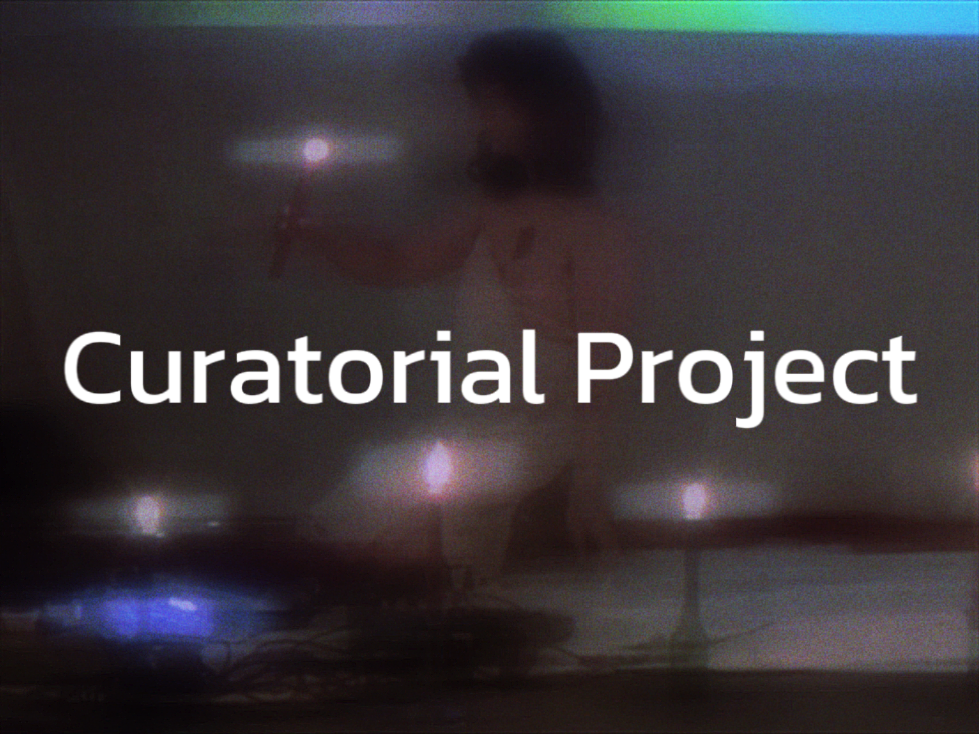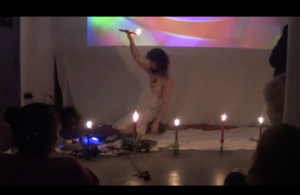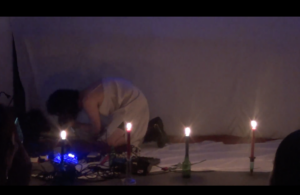Week4 Blog|Select the theme of the exhibition

◾️ Summary of this Tuesday’s lecture

Picture of Week 4 lecture, Jiamin Zhu, 05/02/2025, taken at Martin Hall.
This Tuesday, James Clegg, curator of Talbot Rice Gallery (TRG), gave a lecture to our class on the theme of “Exhibition Challenge”, which led us to quickly curate an exhibition in 60 minutes. This is not only a curatorial simulation, but also a thought experiment on the nature of curation.
⚫️ The significance of the exhibition: WHY?
At the beginning of the workshop, James asked us to think: Why do we plan an exhibition? What is the purpose of the exhibition?
Through discussion, we summarized some key motivations:
-
Promote dialogue and make narratives visible
-
Deliver historical knowledge and share social/political views
-
Touch the audience’s emotions and enhance resonance through visual experience
-
Give more people the opportunity to participate and interact
These discussions made me realize that an exhibition is not only a display space for artworks, but also a narrative method and a way of social intervention. Exhibitions can challenge existing cognitive structures and allow audiences to rethink the relationship between individuals and society, history and reality.
⚫️ Quick Curation
Under the guidance of James, we quickly entered the practical stage of curation. This challenge not only determines the theme of the exhibition, but also considers the spatial layout, budget, marketing strategy, etc. of the exhibition. Due to time constraints, we were encouraged to make decisions in the most direct and intuitive way, similar to a “curatorial improvisation”.
When discussing the theme of the exhibition, I found several topics recurring:
-
Body Art – expressing identity, power and social relations through body practice
-
Give a Voice to Marginalized People – making art a platform for vulnerable groups to speak out
-
Changes in the Status of Women – exploring the social roles of women in different historical periods
⚫️ Behind-the scenes thinking on exhibition planning
Throughout the curatorial process, James also emphasized that the role of the curator is far more than just selecting works, but also includes:
How to “defend” the exhibition – you need to explain to institutions, sponsors, and audiences why this exhibition deserves to exist
How to manage the budget – marketing, publicity, exhibition layout, venue rental, etc. all require 💰financial planning
How to design the exhibition experience ?How do the audience move in the space? How does the exhibition create emotional resonance?
These contents reminded me that in real curation, many seemingly unavoidable restrictions (budget, space, policy) actually shape the final presentation of the exhibition, and how to find creative solutions within the restrictions is one of the core challenges of curation.
◾️ Curating in Hearing: Exploring Sound, Perception and Space
In curatorial practice, sound is often seen as a supplementary medium, usually attached to visual art. However, with the development of sound studies, auditory phenomenology and perception theory, curators have begun to rethink how sound can independently shape space and become the core of the exhibition experience. This week, my research focuses on “Sensory Curating“, with a particular focus on how sound can generate physical experience, social connection and critical thinking in exhibitions.
⚫️Theoretical framework: Auditory Phenomenology & Deep Listening
My research is based on several core theories:
Pauline Oliveros’ Deep Listening: A Composer’s Sound Practice (2005) emphasizes that listening is not just a passive perceptual process, but an embodied, relational practice. Her Deep Listening method combines meditation, body awareness, and group listening to encourage people to establish deeper connections through sound.
Related quotes:
-
Salomé Voegelin’s auditory phenomenology
Voegelin argues in Listening to Noise and Silence (2010) that auditory perception does not merely reflect reality but actively constructs it.
This offers exciting curatorial possibilities: how might exhibitions foreground listening as a mode of world-building, rather than relying on vision as the dominant means of engagement?
-
Oliveros defines “deep listening” as:
“Deep Listening is a practice that is intended to heighten and expand consciousness of sound in as many dimensions of awareness and attentional dynamics as humanly possible.”
-
She emphasizes the embodiment of listening:
“Listening is directing attention to what is heard, gathering meaning, interpreting and deciding on action.”
-
I will guide the audience into an immersive listening state through the spatial design of the exhibition, such as setting up a quiet meditation area or a sound perception laboratory.
-
In addition, collective listening experiences can be added to allow the audience to interact in a specific sound environment to stimulate thinking about the relationship between sound and body.
-
And use cross-sensory experience in the curatorial design process, such as incorporating tactile or visual elements, so that the audience can “listen” to the exhibition in non-traditional ways.
Oliveros’s approach is not only about “listening”, but also about “how to listen”, and prompts the audience to establish a relationship with sound and space in a more embodied way. For my curation, this can be an important strategy to enhance the audience’s physical experience.
◾️ Case Study: Listen Gallery
This week, in addition to theoretical explorations, I am also looking at small, non-institutional sound curatorial practices to see how they can transform large, abstract auditory concepts into concrete artistic experiences.
⚫️Listen Gallery in Glasgow: A small curatorial space focused on sound art, exploring how sound can be used as the primary medium in exhibitions, rather than as a secondary element.
Yasmine Des Astres《Dounia》

Footnote Photographer, Yasmine Des Astres at the event. 2024, Instagram, accessed February 11, 2025, https://www.instagram.com/reel/DBbTR3dKd6C/?igsh=cHN3bHk4ZnhxNzVi.
Yasmine Des Astres’s exhibition was performed at the Listen Gallery. Dounia explores the “Dounia” (material world) in Islamic philosophy through the interweaving of sound and vision, and creates an immersive prayer space about unity and love at the sensory level. The core of the exhibition is sound – it is not only a medium for narrative, but also a link between individuals and space, individuals and the collective. Sound waves are given emotional thickness in the exhibition, interacting with the space, allowing the viewer’s perception to transcend vision and enter a psychological landscape constructed by echoes, resonances, and low-frequency pulsations.
Space here is not only a physical exhibition hall, but also a spiritual resonance body. It calls the viewer into the “night world” created by Des Astres, a place full of desire, pain, intimacy, rupture and repair.
Space as an extension of perception:
Through the careful arrangement of space, the exhibition makes the audience not only a “viewer”, but also a “listener” and “resonator”. This method breaks the traditional viewing mode and emphasizes the perceptual role of the body in the exhibition. For example, low-frequency vibrations may affect the body, and the reverberation of sound may create an illusion of time. These strategies are worth learning from.
How to create sensory unity in curating?
The exhibition uses the fusion of sound and visual elements to make the sensory experience holistic rather than fragmented. Therefore, in my project, the theme of the exhibition can be strengthened through the interaction between different media (light, shadow, sound, touch, etc.), so that the viewer can experience the progression of concepts in a multi-level perception process.
⚫️Future curatorial ideas
Atypical spaces and deep listening
Based on the above research, my curatorial projects may focus on:
-
Space selection: Try to bring exhibitions into non-traditional spaces, such as industrial sites, underground tunnels, or intervene in urban spaces through mobile sound installations.
-
Artist collaboration:
-
Perceptual experience: Using Pauline Oliveros’s deep listening method, the exhibition is not just a passive viewing space, but a multi-dimensional perceptual field.
Bibliography
Oliveros, Pauline. 2005. Deep Listening : A Composer’s Sound Practice. New York: Universe.
Rusu, Dragoș Rusu. 2020. “Pauline Oliveros | the Attic.” The Attic. The Attic. November 16, 2020. https://theatticmag.com/audio/2386/pauline-oliveros.html.
Salomé Voegelin. 2010. Listening to Noise and Silence. Bloomsbury Publishing USA.
Week4 Blog|Select the theme of the exhibition / Jiamin Zhu / Curating (2024-2025)[SEM2] by is licensed under a
Week4 Blog|Select the theme of the exhibition / Jiamin Zhu / Curating (2024-2025)[SEM2] by is licensed under a





